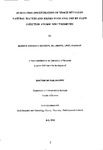IN-SITU PRECONCENTRATION OF TRACE METALS IN NATURAL WATERS AND BRINES WITH ANALYSIS BY FLOW INJECTION ATOMIC SPECTROMETRY
| dc.contributor.author | NICKSON, ROBERT ANTHONY | |
| dc.contributor.other | School of Geography, Earth and Environmental Sciences | en_US |
| dc.date.accessioned | 2013-10-08T11:06:11Z | |
| dc.date.available | 2013-10-08T11:06:11Z | |
| dc.date.issued | 1998 | |
| dc.identifier | NOT AVAILABLE | en_US |
| dc.identifier.uri | http://hdl.handle.net/10026.1/2091 | |
| dc.description.abstract |
Atomic spectrometric techniques such as ICP-MS offer exceptional sensitivity and multi-element capability for trace metal analysis but the formation of polyatomic ions (particularly below m/z = 80) can cause serious interferences. Such interfering species may be introduced via precursor atoms in atmospheric gases, the sample matrix or impurities in the reagents and gases. There is an environmental need to establish rapid multi-element methods of analysis for trace metals in environmental waters and the subsequent speciation of these trace elements. Natural waters, particularly those with a high dissolved solids content such as sea water are difficult to analyse directly by ICP techniques due to the sample matrix forming polyatomic ion interferences when using ICP-MS and matrix modification of the background when undertaking ICP-AES studies. This thesis describes the development of analytical methodologies involving on-line sample preconcentration and matrix removal for the determination of trace elements in natural waters and brines using ICP-MS and ICPAES detection for the determination of a suite of trace elements including cadmium, cobalt, copper, lead manganese, nickel, selenium and zinc. Chapter one summarises the techniques used for such analyses and a review of solid phases used for sample preconcentration and matrix removal is given. Chapter two describes the development of an on-line Fl-atomic spectrometric matrix elimination method for the determination of trace metals in the samples discussed. The method involved the chelation of the analytes onto a Metpac CC-1® IDA resin with the simultaneous removal of matrix ions, e.g. Na and CI. The method was successfully validated for the analysis of open ocean sea water and riverine water, and the application of FI-FAAS to the determination of Mn in riverwater using extended preconcentration times to improve sensitivity is described. The influence of sample matrix on the atomic emission of these trace analytes is also discussed. Chapter three describes the application of the developed method to the quantification of trace elements in produced water samples from the north sea oil and gas production fields. Results using FI-ICP-MS and FI-ICP-AES are compared, and a sample is digested using U.V. radiation in order to determine the amount of trace analytes bound to organic material. The influence of matrix concentration on analyte retention and column capacity is investigated, and data obtained from a series of breakthrough curves is used to predict the maximum breakthrough volumes of sample required before analyte is lost as the operating capacity of the column is exceeded, for samples of differing salinities. Chapter four describes the development of an in-situ method of preconcentration of a suite of trace elements using the column system described previously. In-situ preconcentration offers a number of advantages over traditional sample collection and preservation techniques and minimises the potential for sample contamination. The in-situ method involves the use of a battery powered preconcentration unit containing columns, reagents and suitable reagent and sample pumping facilities, and subsequent analysis of these samples in the laboratory by the use of FI-ICP-AES. The method is successfully validated using a coastal sea water certified reference material, and the method is applied to the determination of trace elements in a sample taken from the Tamar Estuary, Devon. Chapter five describes the development of an on-line FI preconcentration-HG-ICP-AES method for the speciation of inorganic selenium in water. Sample was preconcentrated on a Benson BA-XIO® exchange resin. On-line separation of Se(IV) and Se(VI) was achieved, and sensitivity was improved by the adoption of hydride generation prior to analysis for the determination of Se(IV). Se(VI) was determined after off-line pre-reduction to Se(IV). The method was tested by the determination of inorganic selenium in an SRM, NIST 1643C, Trace elements in water and results compared with previous work. | en_US |
| dc.description.sponsorship | Shell Research and Technology Centre, Thornton, Shell Research Limited | en_US |
| dc.language.iso | en | en_US |
| dc.publisher | University of Plymouth | en_US |
| dc.title | IN-SITU PRECONCENTRATION OF TRACE METALS IN NATURAL WATERS AND BRINES WITH ANALYSIS BY FLOW INJECTION ATOMIC SPECTROMETRY | en_US |
| dc.type | Thesis | |
| plymouth.version | Full version | en_US |
| dc.identifier.doi | http://dx.doi.org/10.24382/4921 | |
| dc.identifier.doi | http://dx.doi.org/10.24382/4921 |
Files in this item
This item appears in the following Collection(s)
-
01 Research Theses Main Collection
Research Theses Main


